1. Abelson JS, Chartrand G, Moo TA, Moore M, Yeo H. The climb to break the glass ceiling in surgery: trends in women progressing from medical school to surgical training and academic leadership from 1994 to 2015. Am J Surg. 2016; 212(4):566–572.e1. PMID:
27649976.

2. Radunz S, Pustu H, Marx K, Mazilescu L, Braun A, Benkö T, et al. Women in surgery: a web-based survey on career strategies and career satisfaction. Innov Surg Sci. 2020; 5(1-2):11–19. PMID:
33506089.

3. Siotos C, Payne RM, Stone JP, Cui D, Siotou K, Broderick KP, et al. Evolution of workforce diversity in surgery. J Surg Educ. 2019; 76(4):1015–1021. PMID:
30638794.

5. General Medical Council (GMC). The State of Medical Education and Practice in the UK. London, UK: GMC;2017.
7. Korean Educational Statistics Service. Number of graduates by department. Accessed September 13, 2020.
https://kess.kedi.re.kr
.
11. Fitzgerald JE, Tang SW, Ravindra P, Maxwell-Armstrong CA. Gender-related perceptions of careers in surgery among new medical graduates: results of a cross-sectional study. Am J Surg. 2013; 206(1):112–119. PMID:
22902099.

12. Dorsey ER, Jarjoura D, Rutecki GW. The influence of controllable lifestyle and sex on the specialty choices of graduating U.S. medical students, 1996–2003. Acad Med. 2005; 80(9):791–796. PMID:
16123455.

13. Tambyraja AL, McCrea CA, Parks RW, Garden OJ. Attitudes of medical students toward careers in general surgery. World J Surg. 2008; 32(6):960–963. PMID:
18330624.

14. Zhuge Y, Kaufman J, Simeone DM, Chen H, Velazquez OC. Is there still a glass ceiling for women in academic surgery? Ann Surg. 2011; 253(4):637–643. PMID:
21475000.

15. Kerr HL, Armstrong LA, Cade JE. Barriers to becoming a female surgeon and the influence of female surgical role models. Postgrad Med J. 2016; 92(1092):576–580. PMID:
27528701.

16. Peel JK, Schlachta CM, Alkhamesi NA. A systematic review of the factors affecting choice of surgery as a career. Can J Surg. 2018; 61(1):58–67. PMID:
29368678.

17. Yu TC, Jain A, Chakraborty M, Wilson NC, Hill AG. Factors influencing intentions of female medical students to pursue a surgical career. J Am Coll Surg. 2012; 215(6):878–889. PMID:
23021827.

18. Webster F, Rice K, Christian J, Seemann N, Baxter N, Moulton CA, et al. The erasure of gender in academic surgery: a qualitative study. Am J Surg. 2016; 212(4):559–565. PMID:
27640905.

19. Nora LM, McLaughlin MA, Fosson SE, Stratton TD, Murphy-Spencer A, Fincher RM, et al. Gender discrimination and sexual harassment in medical education: perspectives gained by a 14-school study. Acad Med. 2002; 77(12 Pt 1):1226–1234. PMID:
12480632.
20. Stratton TD, McLaughlin MA, Witte FM, Fosson SE, Nora LM. Does students' exposure to gender discrimination and sexual harassment in medical school affect specialty choice and residency program selection? Acad Med. 2005; 80(4):400–408. PMID:
15793027.

21. Bruce AN, Battista A, Plankey MW, Johnson LB, Marshall MB. Perceptions of gender-based discrimination during surgical training and practice. Med Educ Online. 2015; 20(1):25923. PMID:
25652117.

22. Cochran A, Hauschild T, Elder WB, Neumayer LA, Brasel KJ, Crandall ML. Perceived gender-based barriers to careers in academic surgery. Am J Surg. 2013; 206(2):263–268. PMID:
23414631.

23. Sexton KW, Hocking KM, Wise E, Osgood MJ, Cheung-Flynn J, Komalavilas P, et al. Women in academic surgery: the pipeline is busted. J Surg Educ. 2012; 69(1):84–90. PMID:
22208838.

24. Amrein K, Langmann A, Fahrleitner-Pammer A, Pieber TR, Zollner-Schwetz I. Women underrepresented on editorial boards of 60 major medical journals. Gend Med. 2011; 8(6):378–387. PMID:
22153882.

25. Harris CA, Banerjee T, Cramer M, Manz S, Ward ST, Dimick J, et al. Editorial (spring) board? Gender composition in high-impact general surgery journals over 20 years. Ann Surg. 2019; 269(3):582–588. PMID:
29342020.

27. Mueller AS, Jenkins TM, Osborne M, Dayal A, O'Connor DM, Arora VM. Gender differences in attending physicians' feedback to residents: a qualitative analysis. J Grad Med Educ. 2017; 9(5):577–585. PMID:
29075375.

28. Meyerson SL, Sternbach JM, Zwischenberger JB, Bender EM. The effect of gender on resident autonomy in the operating room. J Surg Educ. 2017; 74(6):e111–e118. PMID:
28669788.

29. Longo P, Straehley CJ. Whack! I've hit the glass ceiling! Women's efforts to gain status in surgery. Gend Med. 2008; 5(1):88–100. PMID:
18420169.

30. Blumenthal DM, Bergmark RW, Raol N, Bohnen JD, Eloy JA, Gray ST. Sex differences in faculty rank among academic surgeons in the United States in 2014. Ann Surg. 2018; 268(2):193–200. PMID:
29334559.

31. Basford TE, Offermann LR, Behrend TS. Do you see what I see? Perceptions of gender microaggressions in the workplace. Psychol Women Q. 2014; 38(3):340–349.

32. Olkin R, Hayward HS, Abbene MS, VanHeel G. The experiences of microaggressions against women with visible and invisible disabilities. J Soc Issues. 2019; 75(3):757–785.

33. Shin HY, Lee HA. The current status of gender equity in medicine in Korea: an online survey about perceived gender discrimination. Hum Resour Health. 2020; 18(1):78. PMID:
33081799.

34. Korean Medical Women's Association. A Study on the Improvement of Female Doctor Marriage and Childbirth Environment. Seoul, Korea: Korean Medical Women's Association;2011.
35. Carr PL, Ash AS, Friedman RH, Szalacha L, Barnett RC, Palepu A, et al. Faculty perceptions of gender discrimination and sexual harassment in academic medicine. Ann Intern Med. 2000; 132(11):889–896. PMID:
10836916.

36. Coombs AA, King RK. Workplace discrimination: experiences of practicing physicians. J Natl Med Assoc. 2005; 97(4):467–477. PMID:
15868767.
37. Stephens EH, Heisler CA, Temkin SM, Miller P. The current status of women in surgery: how to affect the future. JAMA Surg. 2020; 155(9):876–885. PMID:
32639556.
38. Carr PL, Szalacha L, Barnett R, Caswell C, Inui T. A “ton of feathers”: gender discrimination in academic medical careers and how to manage it. J Womens Health (Larchmt). 2003; 12(10):1009–1018. PMID:
14709189.

39. Rogers AC, Wren SM, McNamara DA. Gender and specialty influences on personal and professional life among trainees. Ann Surg. 2019; 269(2):383–387. PMID:
29099401.

40. Pories SE, Turner PL, Greenberg CC, Babu MA, Parangi S. Leadership in American surgery: women are rising to the top. Ann Surg. 2019; 269(2):199–205. PMID:
30048312.
41. Dossa F, Baxter NN. Reducing gender bias in surgery. Br J Surg. 2018; 105(13):1707–1709. PMID:
30462365.

42. Gargiulo DA, Hyman NH, Hebert JC. Women in surgery: do we really understand the deterrents? Arch Surg. 2006; 141(4):405–407. PMID:
16618901.
43. Lee YG, Oh S, Kimm H, Koo DH, Kim DY, Kim BS, et al. Practice patterns regarding multidisciplinary cancer management and suggestions for further refinement: results from a national survey in Korea. Cancer Res Treat. 2017; 49(4):1164–1169. PMID:
28231425.

44. Chung DB, Chang YJ, Kang SN, Kye SY, Yun YH, Lee DR. A comparison of clinical oncologists and family physicians toward complementary and alternative medicine in South Korea: perceptions, attitudes and physician-patient communication. Korean J Fam Med. 2010; 31(1):24–34.

45. Song KW, Kim HK. Job stress and its related factors among Korean dentists: an online survey study. Int Dent J. 2019; 69(6):436–444. PMID:
31388997.

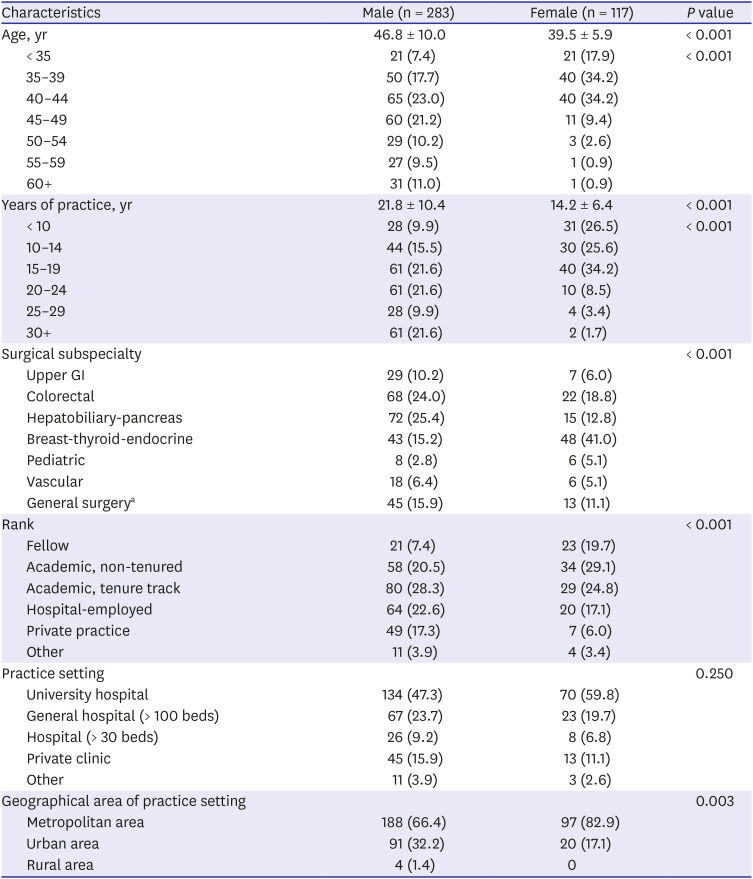
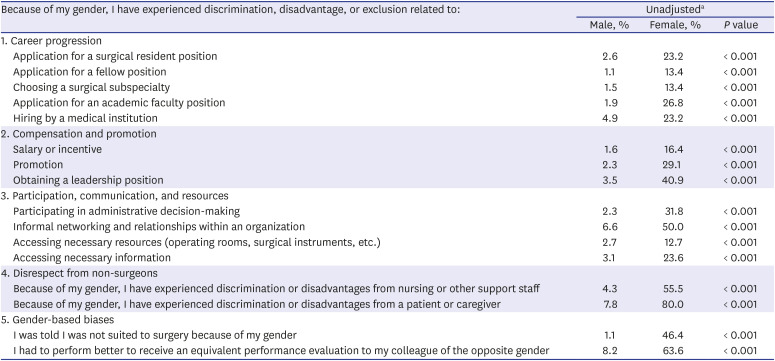
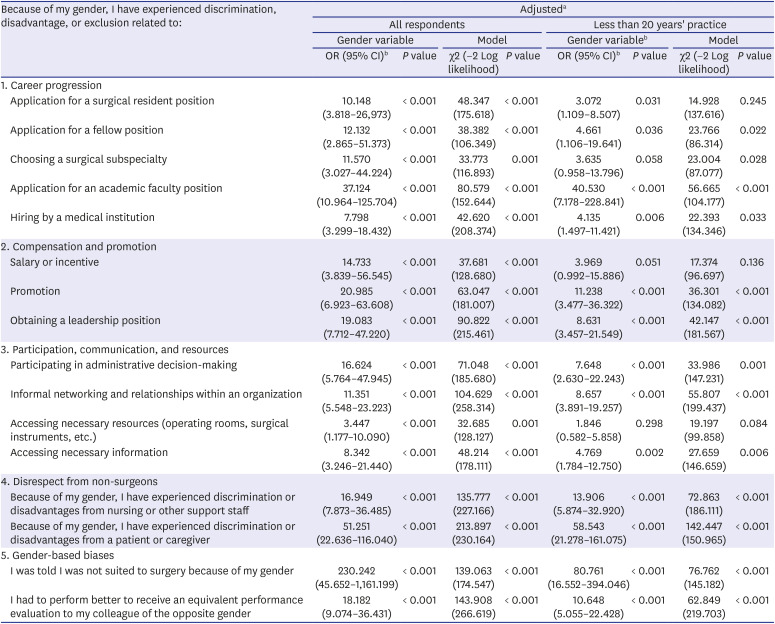
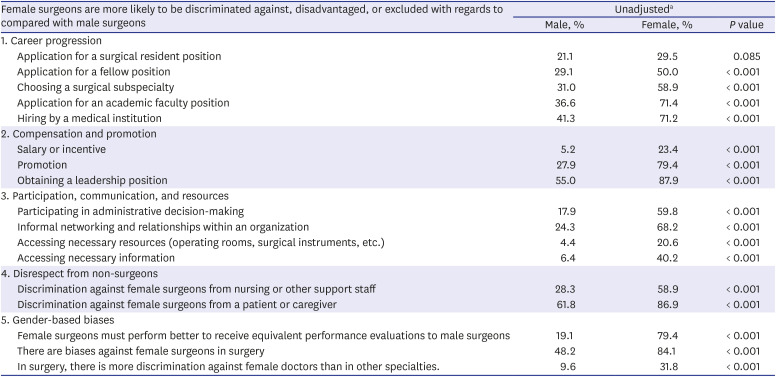
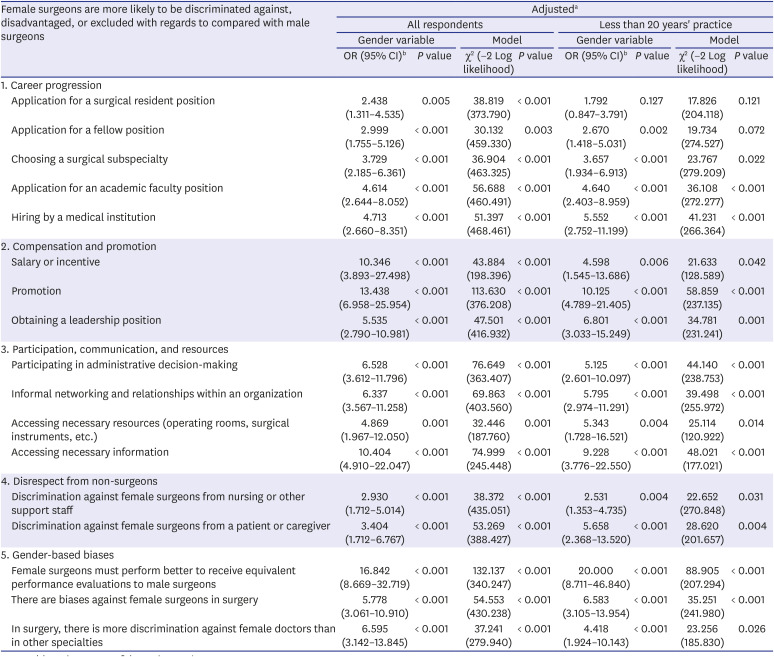




 PDF
PDF Citation
Citation Print
Print



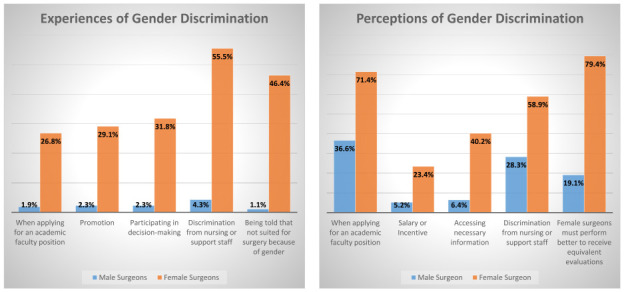
 XML Download
XML Download